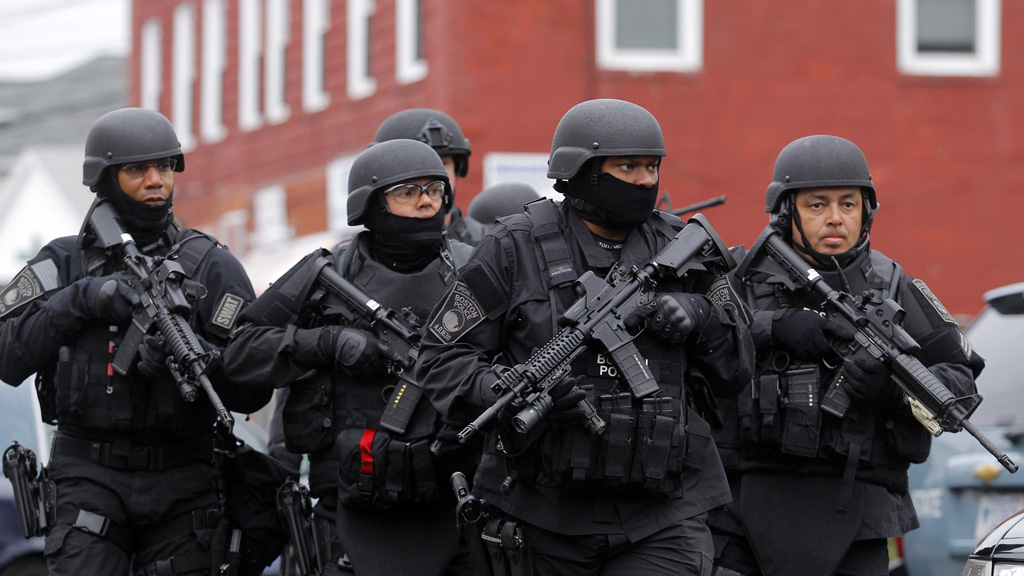Boston bombings: how the suspects were tracked down
A night of chaos and terror on the outskirts of Boston. Gunfire, explosions, a police chase: one suspect dead, another, armed – still at large. But how did the authorities track them down?

The residents of the Boston suburb of Watertown have never known a night like it. A police officer from the prestigious MIT was killed, another officer wounded, then an SUV was hijacked before a terrifying police chase.
As officers came under fire from a hail of explosives, one of the two suspects was shot: he later died in hospital. The other after several hours and a vast police operation involving thousands of officers, is still at large.
Boston Police Commissioner Ed Davis said “We believe this to be a terrorist. We believe this to be a man who has come here to kill people. We need to get him in custody.”
The drama unfolded after the FBI released photographs and video of two men who were seen wearing backpacks and baseball caps in the crowd at the Boston marathon, shortly before the two bombs went off.
Breaking cover
Sources suggest that the two suspects broke cover and tried to flee after their pictures were published, fearing that they would be identified: five hours later, the MIT police officer was shot and killed.
We believe this is a man who came here to kill people. Boston police commander Ed Davis
Much of the most reliable information as events unfolded has come from NBC’s justice reporter Pete Williams, who advised caution when cable news was (wrongly) reporting that a suspect had been arrested two days ago.
Security officials now say the family came to America seeking refuge from the war in Chechnya: the two brothers arrived separately, in 2002 and 2004. They had been living legally in the United States for a year; one had a driving licence registered in Massachusetts.
The brothers was quickly named by several sources – NBC and AP among them – as 19 year old Dzhokhar A Tsarnaev, and his 26 year old brother Tamerlan. The younger Tsarnaev has a page on the Russian social networking site Vkontakti, which was soon all over the mainstream media.
More information was soon broadcast about his Tamerlan – who was killed during the confrontation with police, including one report that he was once arrested for assault.
However the Tsarnaev’s uncle and aunt have both insisted the boys never went to Chechnya. Information is still highly confusing.
Suspects named by media
NBC’s Williams says the two are likely to have had “foreign military training”, given the nature of the attack.
Large parts of greater Boston around Watertown are still in lockdown: the transport system has been suspended, local residents warned to stay in their homes. Military SWAT type teams are all over the area, taking up position outside residential homes near the suspects’ home address.
The FAA closed low-level airspace over north west Boston to “provide a safe environment for law enforcement activities.”
Crucially, the identification of the two suspects was helped by State Department records, which the FBI was able to match to their photographs from the bombing scene.
NBC, again, reports that the two young men were not unknown to the intelligence agencies in the United States.
Bag. Saw the guy. Looked right at me. Jeff Bauman, injured in Boston bomb attack
And then came an astonishing story, reported by Bloomberg. One of the victims of the marathon bombing, catastrophically injured in the attack, was himself a key part in the identification of the suspects.
Jeff Bauman, who is 27, was waiting in the crowd for his girlfriend to finish the race. His brother told the agency that a man dressed in a cap, sunglasses and a hooded sweatshirt looked straight at Jeff, and dropped a bag at his feet.
Minutes later, the bag exploded: Jeff was rushed to hospital, where both his legs were amputated below the knee. Says Chris Bauman: “He woke up under so much drugs, asked for a paper and pen, and wrote: ‘bag, saw the guy, looked right at me’.”
From his bed in intensive care, Jeff Bauman managed to give the FBI a clear description – which may have provided vital clues for investigators trying to track the bombers down.
Red herrings
It is all a very different story from the long hours of online speculation on social media sites, the mistaken naming of suspects, the so-called “internet vigilantes” who had trawled through endless photographs of crowds at the marathon. Red herrings, all of it, as it appears to be turning out.
Much of the information is now coming from people glued to police scanners, rapidly tweeting anything they hear. Eyewitness accounts, and dramatic photographs of the terror in Watertown which has been unfolding during the night have been re-tweeted around the world.
None of this, however, is likely to mark an end to the speculation: the search for possible motives has already begun. Which known terror groups have links to Chechnya? What of the teenage suspect’s interests, on his Vkontakti page, in Islamic and other Chechen nationalist issues?
And why Boston? Why now?
The lesson of the last few, chaotic hours appears to be this. Facts, not rumours, are the only currency that matters. Especially with an armed, and highly dangerous suspect, still at large. Stay tuned, for updates.
Felicity Spector writes about US politics for Channel 4 News
-
Latest news
-
Laughing Boy: New play tells the tragic tale of Connor Sparrowhawk5m

-
Sewage warning system allows some of worst test results to be left off rating system, analysis shows3m

-
Post Office inquiry: Former CEO didn’t like word “bugs” to refer to faulty IT system4m

-
Israeli soldier speaks out on war in Gaza12m

-
PM’s defence spending boost should be ‘celebrated’, says former Armed Forces Minister4m

-




